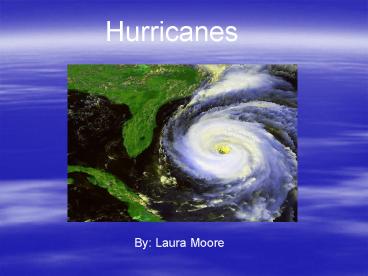Hurricanes - PowerPoint PPT Presentation
1 / 13
Title:
Hurricanes
Description:
We are going to define key words and verbally recall conditions that must be ... to turn around rapidly, as on an axis; twirl; whirl: to spin a coin on a table. ... – PowerPoint PPT presentation
Number of Views:30
Avg rating:3.0/5.0
Title: Hurricanes
1
Hurricanes
By Laura Moore
2
Hello Class!!
- Today we are going to learn about Hurricanes!
- We are going to define key words and verbally
recall conditions that must be present for a
hurricane to form. - Please raise your hand if you think you know what
a hurricane is - Do any of you know how a hurricane is formed?
3
- What is a hurricane?
- A hurricane is a huge storm!
- It can be up to 600 miles across and have strong
winds spiraling inward and upward at speeds of 75
to 200 mph. - Each hurricane usually lasts for over a week,
moving 10-20 miles per hour over the open ocean. - Hurricanes gather heat and energy through contact
with warm ocean waters. Evaporation from the
seawater increases their power. - Hurricanes rotate in a counter-clockwise
direction around an "eye." The center of the
storm or "eye" is the calmest part. - It has only light winds and fair weather. When
they come onto land, the heavy rain, strong winds
and large waves can damage buildings, trees and
cars.
4
The eye of a Hurricane
5
How do hurricanes form?
- Hurricanes only form over really warm ocean water
of 80F or warmer. - The atmosphere (the air) must cool off very
quickly the higher you go. - Also, the wind must be blowing in the same
direction and at the same speed to force air
upward from the ocean surface. - Winds flow outward above the storm allowing the
air below to rise. - Hurricanes typically form between 5 to 15 degrees
latitude North and South of the equator. The
Coriolis Force is needed to create the spin in
the hurricane and it becomes too weak near the
equator, so hurricanes can never form there.
6
When does hurricane season start?
- The Atlantic hurricane season is from June 1 to
November 30, but most hurricanes occur during the
fall months. - The Eastern Pacific hurricane season is from May
15 to November 30. (Below is a graphic that shows
you when hurricanes are most active across parts
of the world.)
7
(No Transcript)
8
Vocabulary
- Hurricane- a violent, tropical, cyclonic storm of
the western North Atlantic, having wind speeds of
or in excess of 72 mph (32 m/sec). - Cyclone- a large-scale, atmospheric
wind-and-pressure system characterized by low
pressure at its center and by circular wind
motion - Spiraling- spiraling hurricane shape because of
the Coriolis Force, generated by the rotation of
the Earth. This is the same force that causes the
south-blowing African jet to bend westward over
the Atlantic, spawning easterly waves. - Spinning- to cause to turn around rapidly, as on
an axis twirl whirl to spin a coin on a table.
- Humidity- humid condition moistness dampness.
9
Safety Tips!
- BEFORE A HURRICANE Have a disaster plan and a
pet plan ready. Before a storm threatens, contact
your veterinarian or local humane society for
information on preparing your pets for an
emergency. Board up windows and bring in outdoor
objects that could blow away. Make sure you know
which county or parish you live in and know where
all the evacuation routes are.
10
More Safety Tips
- DURING A HURRICANE Stay away from low-lying and
flood prone areas. Always stay indoors during a
hurricane, because strong winds will blow things
around. Leave mobile homes and to go to a
shelter. If your home isnt on higher ground, go
to a shelter. If emergency managers say to
evacuate, then do so immediately.
11
More Safety Tips
- AFTER A HURRICANE Stay indoors until it is safe
to come out. Check for injured or trapped people,
without putting yourself in danger. Watch out for
flooding which can happen after a hurricane. Do
not attempt to drive in flooding water. Stay away
from standing water. It may be electrically
charged from underground or downed power lines.
Dont drink tap water until officials say its
safe to do so.
12
Exit Slip
- On a piece of paper, briefly write down three
things you learned about hurricanes today and
write down three safety tips you learned as well.
13
- Excellent job participating today class!!
Thumbs Up!!!





























